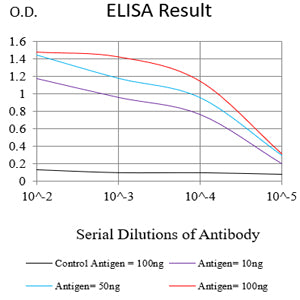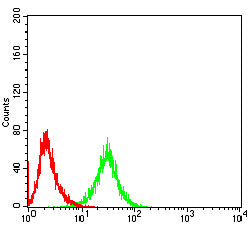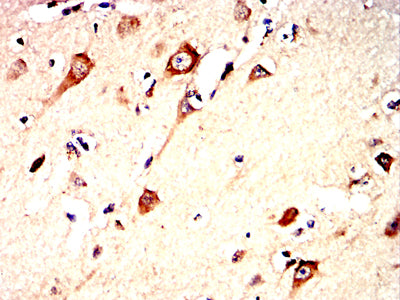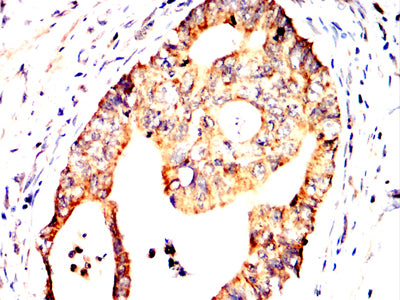



| WB | 咨询技术 | Human,Mouse,Rat |
| IF | 咨询技术 | Human,Mouse,Rat |
| IHC | 1/200 - 1/1000 | Human,Mouse,Rat |
| ICC | 技术咨询 | Human,Mouse,Rat |
| FCM | 1/200 - 1/400 | Human,Mouse,Rat |
| Elisa | 1/10000 | Human,Mouse,Rat |
| Aliases | SCDO1 |
| Entrez GeneID | 10683 |
| clone | 1H9C2 |
| WB Predicted band size | 65KDa |
| Host/Isotype | Mouse IgG1 |
| Antibody Type | Primary antibody |
| Storage | Store at 4°C short term. Aliquot and store at -20°C long term. Avoid freeze/thaw cycles. |
| Species Reactivity | Human |
| Immunogen | Purified recombinant fragment of human DLL3 (AA: extra 27-226) expressed in E. Coli. |
| Formulation | Purified antibody in PBS with 0.05% sodium azide |
+ +
以下是3-4条关于DLL3抗体的参考文献及其简要摘要:
---
1. **文献名称**: *DLL3: An Emerging Target in Small Cell Lung Cancer*
**作者**: Saunders LR, et al.
**摘要**: 该研究揭示了DLL3作为小细胞肺癌(SCLC)特异性生物标志物的潜力,并开发了一种靶向DLL3的抗体-药物偶联物(ADC),在临床前模型中显示出显著抗肿瘤活性。
2. **文献名称**: *Rovalpituzumab Tesirine, a DLL3-Targeted Antibody-Drug Conjugate, in Recurrent Small Cell Lung Cancer*
**作者**: Rudin CM, et al.
**摘要**: 临床试验评估了抗DLL3抗体偶联药物Rovalpituzumab Tesirine(Rova-T)在复发性小细胞肺癌患者中的疗效,发现高DLL3表达患者的总生存期有所延长,但伴随一定毒性。
3. **文献名称**: *DLL3-CAR T Cells Exhibit Potent Activity in Preclinical Models of Small Cell Lung Cancer*
**作者**: Puca L, et al.
**摘要**: 研究构建了靶向DLL3的嵌合抗原受体(CAR)T细胞,并在小细胞肺癌动物模型中验证了其抗肿瘤效果,为DLL3抗体在免疫治疗中的应用提供了依据。
4. **文献名称**: *DLL3 Expression and Its Association with Clinical Outcomes in Neuroendocrine Tumors*
**作者**: Morgensztern D, et al.
**摘要**: 该文献通过免疫组化分析DLL3在多种神经内分泌肿瘤中的表达水平,发现其与患者预后相关,支持DLL3抗体在诊断和靶向治疗中的潜在价值。
---
这些文献覆盖了DLL3抗体在诊断、药物开发和免疫治疗中的关键研究进展。如需具体文章链接或补充信息,可进一步说明。
**Background of DLL3 Antibodies**
DLL3 (Delta-like ligand 3), a member of the Notch signaling pathway ligand family, plays a critical role in cell differentiation and development. Unlike other Delta-like ligands, DLL3 primarily acts as an inhibitory ligand, modulating Notch signaling through cis-inhibitory interactions. It is minimally expressed in healthy adult tissues but is frequently overexpressed in neuroendocrine-derived cancers, particularly small cell lung cancer (SCLC) and high-grade neuroendocrine tumors. This tumor-specific expression makes DLL3 a promising therapeutic target.
DLL3-targeted antibodies, often engineered as antibody-drug conjugates (ADCs) or bispecific antibodies, aim to exploit this antigen for cancer therapy. For example, rovalpituzumab tesirine (Rova-T), an ADC linking an anti-DLL3 antibody to a cytotoxic payload, showed early promise in SCLC but faced challenges in clinical trials due to efficacy and toxicity limitations. Current research focuses on optimizing DLL3 antibody designs, such as T-cell-engaging bispecific antibodies (e.g., AMG 757 and AMG 119), which redirect immune cells to DLL3-expressing tumors.
Structurally, DLL3’s extracellular domain contains multiple EGF-like repeats, enabling selective antibody binding. However, its intracellular trafficking and membrane-proximal localization pose challenges for antibody accessibility. Despite these hurdles, DLL3 remains a key focus in oncology, with ongoing efforts to refine targeting strategies and improve therapeutic outcomes in aggressive cancers.
×